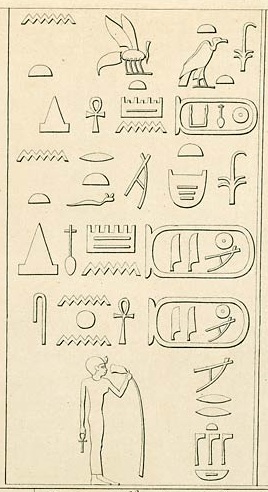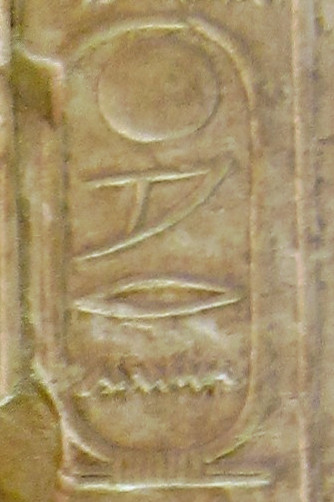|
Ankhesenmeryre
Ankhesenpepi (Ankhesenpepy, Ankhenespepi, Ankhenespepy) was the name of four queen consorts during the sixth dynasty of Egypt. The name means “Her life belongs to Pepi”. Two of them were married to Pharaoh Pepi I (whose throne name was ''Meryre;'' these two ladies were also known as ''Ankhesenmeryre''), the other two were married to Pharaoh Pepi II. * Ankhesenpepi I, wife of Pepi I, mother of Merenre Nemtyemsaf * Ankhesenpepi II, wife of Pepi I, mother of Pepi II * Ankhesenpepi III, daughter of Nemtyemsaf, wife of Pepi II * Ankhesenpepi IV, wife of Pepi II, possible mother of Neferkara I Neferkare or Nefkara may refer to: Pharaohs * Neferkara I, 2nd Dynasty * Pepi II Neferkare, 6th Dynasty * Neferkare II, 8th Dynasty * Neferkare Neby, 8th Dynasty * Neferkare Khendu, 8th Dynasty * Neferkare Tereru, 8th Dynasty * Neferkare Pep ... {{given name Ancient Egyptian given names Egyptian feminine given names ... [...More Info...] [...Related Items...] OR: [Wikipedia] [Google] [Baidu] |
Pepi II
Pepi II Neferkare (2284 BC – after 2247 BC, probably either 2216 or 2184 BC) was a pharaoh of the Sixth Dynasty in Egypt's Old Kingdom who reigned from 2278 BC. His second name, Neferkare (''Nefer-ka-Re''), means "Beautiful is the Ka of Re". He succeeded to the throne at age six, after the death of Merenre I. Pepi II's reign marked a sharp decline of the Old Kingdom. As the power of the nomarchs grew, the power of the pharaoh declined. With no dominant central power, local nobles began raiding each other's territories and the Old Kingdom came to an end within a couple of years after the close of Pepi II's reign. Early years of Pepi II's reign He was traditionally thought to be the son of Pepi I and Queen Ankhesenpepi II, but the South Saqqara Stone annals record that Merenre had a minimum reign of 11 years. Several 6th Dynasty royal seals and stone blocks – the latter of which were found within the funerary temple of Queen Ankhesenpepi II, the known mo ... [...More Info...] [...Related Items...] OR: [Wikipedia] [Google] [Baidu] |
Ankhesenpepi II
Ankhesenpepi II or Ankhesenmeryre II was a queen consort during the Sixth Dynasty of Egypt. She was the wife of Kings Pepi I and Merenre Nemtyemsaf I, and the mother of Pepi II. She likely served as regent during the minority of her son. She was buried in a pyramid in Saqqara. Biography Ankhesenpepi II was the daughter of Khui and the female vizier Nebet. Her sister Ankhesenpepi I was also married to King Pepi I and her brother Djau served as vizier.Aidan Dodson & Dyan Hilton: The Complete Royal Families of Ancient Egypt. Thames & Hudson, 2004, , pp.71-74 Both Ankhesenpepi II and her sister Ankhesenpepi I were married to Pharaoh Pepi I whose throne name was ''Meryre''; their name was taken when the marriage took place, since it means "Her life belongs to Pepi/Meryre". Both queens gave birth to the kings: the son of Ankhesenpepi I was Merenre Nemtyemsaf I, who ruled only for a few years; the son of Ankhesenpepi II was Pepi II, who succeeded after Nemtyemsaf's death. Pepi II w ... [...More Info...] [...Related Items...] OR: [Wikipedia] [Google] [Baidu] |
Pepi I
Pepi I Meryre (also Pepy I) was an ancient Egyptian pharaoh, third king of the Sixth Dynasty of Egypt, who ruled for over 40 years at the turn of the 24th and 23rd centuries BC, toward the end of the Old Kingdom period. He was the son of Teti, the founder of the dynasty, and ascended the throne only after the brief intervening reign of the shadowy Userkare. His mother was Iput, who may have been a daughter of Unas, the final ruler of the preceding Fifth Dynasty. Pepi I, who had at least six consorts, was succeeded by his son Merenre Nemtyemsaf I, with whom he may have shared power in a coregency at the very end of his reign. Pepi II Neferkare, who might also have been Pepi I's son, succeeded Merenre. Several difficulties accumulated during Pepi's reign, beginning with the possible murder of his father and the ensuing reign of Userkare. Later, probably after his twentieth year of reign, Pepi faced a harem conspiracy hatched by one of his consorts who m ... [...More Info...] [...Related Items...] OR: [Wikipedia] [Google] [Baidu] |
Sixth Dynasty Of Egypt
The Sixth Dynasty of ancient Egypt (notated Dynasty VI), along with the Third, Fourth and Fifth Dynasty, constitutes the Old Kingdom of Dynastic Egypt. Pharaohs Known pharaohs of the Sixth Dynasty are listed in the table below. Manetho accords the dynasty 203 regnal years from Teti to Nitocris, while the Turin Canon assigns 181 regnal years, but with three additional kings concluding with Aba – discounting the reigns of the added Eighth Dynasty kings, this is reduced to 155 regnal years. This estimate varies between both scholar and source. History The Sixth Dynasty is considered by many authorities as the last dynasty of the Old Kingdom, although ''The Oxford History of Ancient Egypt'' includes Dynasties VII and VIII as part of the Old Kingdom. Manetho writes that these kings ruled from Memphis, since their pyramids were built at Saqqara, very close one to another. By the Fifth Dynasty, the religious institution had established itself as the dominan ... [...More Info...] [...Related Items...] OR: [Wikipedia] [Google] [Baidu] |
Ankhesenpepi I
Ankhesenpepi I (also Ankhenespepi I or Ankhenesmeryre I) was a queen consort during the Sixth Dynasty of Egypt. Biography Ankhesenpepi was a daughter of the female vizier Nebet and her husband Khui, nomarch of Abydos. Ankhesenpepi's sister was Ankhenespepi II, and her brother was Vizier Djau. Both sisters – Ankhesenpepi I and II – were married to Pharaoh Pepi I whose throne name was ''Meryre;'' their name was probably taken when the marriage took place, since it means "Her life belongs to Pepi/Meryre". Both queens gave birth to successors of Pepi: the son of Ankhesenpepi I was Merenre Nemtyemsaf I, who ruled only for a few years; the son of Ankhenespepi II was Pepi II, who succeeded after Nemtyemsaf's death.Dodson & Hilton, p.71 She is mentioned together with her sister on their brother's stela in Abydos, also, at her pyramid, on an inscription now in Berlin Berlin ( , ) is the capital and largest city of Germany by both area and population. Its 3.7 million inh ... [...More Info...] [...Related Items...] OR: [Wikipedia] [Google] [Baidu] |
Merenre Nemtyemsaf
Merenre Nemtyemsaf I (meaning "Beloved of Ra, Nemty is his protection") was an Ancient Egyptian pharaoh, the fourth king of the sixth dynasty. He ruled Egypt for six to 11 years in the 23rd century BC, succeeding his father Pepi I Meryre on the throne. Family Merenre was the son of queen Ankhesenpepi I and king Pepi I, who probably begot him in his old age. Ankhesenpepi was a daughter of the nomarch of Abydos Khui and his wife Nebet whom Pepi I made into a vizier during his reign, the sole women of the Old Kingdom period known to have held such a title. Khui and Nebet's son, Merenre's uncle Djau served in the position of vizier under Merenre and Pepi II. Merenre had a full sister in princess Neith. Gustave Jéquier has proposed that Neith was married to Merenre, a possibility which Vivienne Callender observes is difficult to ascertain as Neith later remarried to Pepi II, explaining the absence of a tomb of her near Merenre's. Sixth dynasty royal seals and stone blocks foun ... [...More Info...] [...Related Items...] OR: [Wikipedia] [Google] [Baidu] |
Ankhesenpepi III
Ankhesenpepi III was an ancient Egyptian queen of the Sixth Dynasty as a consort of Pepi II, who was probably her uncle. She was a daughter of Nemtyemsaf I and was named after her grandmother, Ankhesenpepi I.Dodson and Hilton: The Complete Royal Families of Ancient Egypt, 2004. pp.72-76 Her titles included: King’s Wife ''(hmt-niswt),'' King’s Daughter ''(z3t-niswt)''. Ankhesenpepi III was buried in a pyramid near that of her grandfather Pepi I Pepi I Meryre (also Pepy I) was an ancient Egyptian pharaoh, third king of the Sixth Dynasty of Egypt, who ruled for over 40 years at the turn of the 24th and 23rd centuries BC, toward the end of the Old Kingdom period. He was the son of .... The main part of her sarcophagus was made of sandstone and embedded in the floor of the burial chamber. The lid of the sarcophagus was made of pink granite.Verner, Pyramids, 1994 References 23rd-century BC women 22nd-century BC women Queens consort of the Sixth Dynasty of E ... [...More Info...] [...Related Items...] OR: [Wikipedia] [Google] [Baidu] |
Ankhesenpepi IV
Ankhesenpepi IV was an ancient Egyptian queen, a wife of Pharaoh Pepi II of the Sixth Dynasty. She was the mother of a crown prince Neferkare. Pepi II also had several other wives. Titles Her titles were: ''King’s Mother of Ankh-djed-Neferkare'' (''mwt-niswt-‘nkh-djd-nfr-k3-r’''), ''Mother of the Dual King'' (''mwt-niswt-biti''), ''King’s Wife of Men-ankh-Neferkare'' (ḥmt-niswt-mn-‘nḫ-nfr-k3-r’), ''King’s Wife, his beloved'' (''ḥmt-niswt mryt.f''), ''This God’s Daughter'' (''z3t-nṯr-tw''), ''Foster Child of Wadjet'' (''sḏtit-w3ḏt''). Tomb Ankhesenpepi IV was buried in Saqqara. Apparently they lacked the appropriate resources for a burial, since she did not have a pyramid built for her. Her sarcophagus, which was made of reused stone, was found in a storeroom belonging to the mortuary temple of Queen Iput II :''About the river in Belarus and Russia see Iput River. For the early 6th dynasty queen, wife of Unas see Iput.'' Iput was an ancient E ... [...More Info...] [...Related Items...] OR: [Wikipedia] [Google] [Baidu] |
Neferkara I
Neferkare or Nefkara may refer to: Pharaohs * Neferkara I, 2nd Dynasty * Pepi II Neferkare, 6th Dynasty * Neferkare II, 8th Dynasty * Neferkare Neby, 8th Dynasty * Neferkare Khendu, 8th Dynasty * Neferkare Tereru, 8th Dynasty * Neferkare Pepiseneb, 8th Dynasty * Neferkare, 9th Dynasty * Neferkare VIII, 10th Dynasty * Neferkare Nebiriau II, 16th Dynasty * Neferkare Setepenre Ramesses IX, 20th Dynasty * Neferkare Amenemnisu, 21st Dynasty * Neferkare Peftjauawybast, king of Herakleopolis Magna during the 25th Dynasty * Neferkare Shabaka, 25th Dynasty * Neferkare (Tanis), king of Tanis during the 26th Dynasty Other people * Neferka, eldest son and heir of Pepi II Neferkare * Neferkare Iymeru Neferkare Iymeru was the ancient Egyptian vizier under king Sobekhotep IV in the 13th Dynasty, in the Second Intermediate Period. Biography Neferkare Iymeru was the son of the ''leader of the broad hall'' Iymeru. Neferkare Iymeru himself is kn ..., vizier during the 13th Dynasty {{hn ... [...More Info...] [...Related Items...] OR: [Wikipedia] [Google] [Baidu] |
Ancient Egyptian Given Names
Ancient history is a time period from the beginning of writing and recorded human history to as far as late antiquity. The span of recorded history is roughly 5,000 years, beginning with the Sumerian cuneiform script. Ancient history covers all continents inhabited by humans in the period 3000 BCAD 500. The three-age system periodizes ancient history into the Stone Age, the Bronze Age, and the Iron Age, with recorded history generally considered to begin with the Bronze Age. The start and end of the three ages varies between world regions. In many regions the Bronze Age is generally considered to begin a few centuries prior to 3000 BC, while the end of the Iron Age varies from the early first millennium BC in some regions to the late first millennium AD in others. During the time period of ancient history, the world population was already exponentially increasing due to the Neolithic Revolution, which was in full progress. While in 10,000 BC, the world population stood ... [...More Info...] [...Related Items...] OR: [Wikipedia] [Google] [Baidu] |





